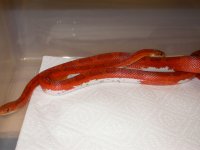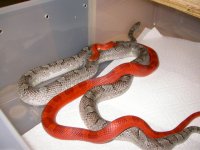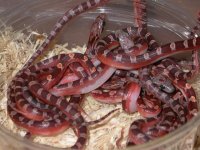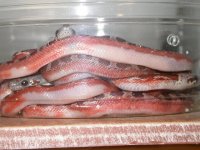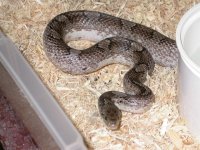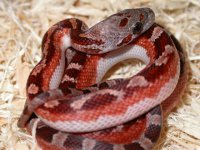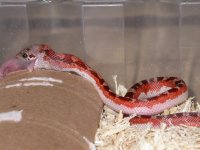After this discussion arose in the Insiders Forum, I'm happy to see it brought to light here where we all have the opportunity to ask questions and learn more about this truly impressive phenotypic look. There really is nothing more stunning to me than that stark red on white look that truly makes you look twice. I did take the time as was suggested to review several threads but re-reading those did make my head spin a little.
I found 3 discussions in this sub-forum made since 2005. There were lots of pics, but discussions to me have some meat on the bone so to speak.
From this thread,
http://www.cornsnakes.com/forums/showthread.php?t=68494&highlight=pied+sided+bloodred in post #6, Terri (Crackerhead) wrote the following...
I know I emailed you this info but I figured everyone should be aware as well so there is no confusion. The Bloodred pied sided that is being referred to in the ad is probably a McDonald line. They have been shown to not breed true. In other words, if you breed two phenotypical McDonald pied sideds you might or might not get offspring that are pied sided. In Don Soderbergs line P/S parents yield P/S offspring. The two lines are also incompatible with one another. If you are looking for nice looking bloodred that have some white on their sides, then great. But if you are looking for breeding stock that will produce P/S, stick to Soderberg's lines. I own both lines. The eggs that are in the incubator from the McDonald line will not be sold as P/S, but rather as nice looking bloodreds, no more, no less.
Terri
The bolding is mine, but this would lead me to believe there is more reliability in reproducing pied sides if the Soderberg line of pied sideds are bred.
In the following thread a discussion about the genetics of white sided in comparison to pied sided Don Soderberg explains the following in post #19...
http://www.cornsnakes.com/forums/showthread.php?t=62475&highlight=pied+sided+bloodred
This is why I caution folks to call these white-sided until we discover if it's polygenic or recessive AND if it is linked only to the darker bloodred compounds. I've seen smattering of white on the sides of anery bloods and pewters for many years. Only recently am I seeing examples that have more and more of it; some to the point of APPEARING white-sided. Are they mimics of the gene or the same recessive mutation seen in many other serpent species?
Although this thread is in reference to 'white sided' and although there is no mention of pied sided at all and whether Mendelian genetics is involved but I included this as genetics was mentioned pertaining to the lack or absence of melanin in bloodreds and that it has been seen in other species. Some confusion was even occuring then about what is white sided and what is actually pied sided.
This is actually the most important thread of all. Started in July 2005, it was my, probably most folks, introduction to this beautiful cultivar. Don originated the post.
http://www.cornsnakes.com/forums/showthread.php?t=23120&highlight=pied+sided+bloodred
I do however find the following quotes interesting.
From Don's post #1...
I understand that he got the male we used to make these from Brad McDonald.
From Don's post #13...
I've been breeding the dam of my line to other bloods for many years and all the babies are classics. Nothing at all unusual from breeding her to several bloodred males over the years. Well, 'till now, that is.
From post #17 by Don...
The jury's still out on the heritable mechanism, but I'm reasonably sure it's recessive from the progeny ratio.
From Don's post #50...
Three years ago before the breeding season, Walter Smith wrote to ask if I have any adult female bloodred corns that would complement his adult male that had a considerable amount of white on it. I had one with "some" white on the sides, ventral-laterally. Sent her to Louisiana and after the breeding season, he returned her with half the babies. Only one of the babies he sent back had traces of white on the sides. I estimate a total of only 20 scales of white. Hence, the indication was that the trait was either not recessive OR that only one of the parents had the gene IF it indeed was a recessive trait. By not seeing the amount of white I'm seeing in the F2s, I was worried it was not recessively inherited.
(The bolding is mine.)
And then he goes on further to state in the same post #50...
As stated before, I got alot of the pied sided corns from those three pairings. The average ratio was just over 1/3 of each litter representing the target phenotype. From these results, I think it's safe to say we're dealing with a recessive trait.
(Again the bolding is mine.)
Now the final post I found was this one
http://www.cornsnakes.com/forums/showthread.php?t=40997
I find post #26 by Danny (dwyn127) to be an interesting one.
I spent alot of time talking to Ward in Daytona two weeks ago about his bloodreds, they were quite stunning. I guess testing has proven them to be non-compatable with the one's Don and Rob are working with. Not sure I understood everything we discussed but then again, it sounds like more testing and info needs to be gathered since the pied side is still so new.
Now I'm left with the question. If the original pied sides were from Walter's McDonald lines bred to Don's lines and produced pied sided, why are Terri's statements above saying Don's lines will produce with reliability pied sides, but the McDonald line won't. Now is this a third line, we are taking about here that Ward has? A non Soderberg, non McDonald line?
Now Terri is not the only one making this statement. From this thread...
http://www.cornsnakes.com/forums/showthread.php?t=66958
In post #8, KJUN says....
It looks like it, but looks alone can't tell you if it is an inheritable form (like Don Soderberg's line). White in bloods isn't THAT new. What is new is the amount of white (and yours has a lot) and the fact that Don is "reliably" reproducing them. No other line does that, and you MAY have one of those lines.
In post #11, same thread, Don says...
On a side-note, it's not news to most bloodred lovers that white has been on the sides of some regular bloods for many years. I saw traces of white on the sides of ones I had back in the mid 1990s and heard of many. Most of those did not pass that trait onto their progeny or grand progeny.
In post #12, Rob says...
Don and KJ have pretty much summed it up.We have seen a couple of lines out there that don't seem to breed true.
These have been around for a while.
The pair of P/S's that i got from Don produced all P/S babies.
Don
does state, "I think it's safe to say we're dealing with a recessive trait." I have found no further posts by Don since April/08 stating it definitely is Mendelian, but others are saying it is inheritable and reproducible reliably.
So now I'm left with a few questions of my own.
If the patriarch of this pied sided line was a McDonald line, and the matriarch was a Soderberg line, why are we differentiating that Soderberg lines breed true, but McDonald lines don't...both were involved genetically to begin with.
If it has not been proven genetic and you pulled your ads because you could not in all honesty claim 'hets for pied sided', then can someone please explain why others are selling these so called hets. :shrugs: To me it seems that until such time as someone is going to publicly state...THIS IS a recessive trait and follows the Mendelian probabilities of genetic inheritance...it's all guess work and optimism. There seems to me to still be a cloud of mystery surrounding the inheritance factor. Doesn't it have to be proved reliable over a few generations to make the claim, 'Yes, this is a recessive gene and has been proven so'. Doesn't it need to be outcrossed and then recaptured? Has this gene even been isolated long enough for this to have been done.
I'm not trying to denigrate, belittle, or make less of this great project whatsoever. I think it's wonderful, but in the hype are many forgetting that the answers are not 'absolute' and are simply caught in awe of the phenotypic look to it all without realizing nothing is guaranteed at this stage. That would be a terrible disappointment for sure if 'buying hets' didn't pan out or investing in homos for other projects proved in the long term to not come out with the expected results.
I hope we get the answers soon. I'd love to see the potential this gene has to offer used in other morphs, especially the anery and hypo groups. Wouldn't that be awesome...almost as good as what we are seeing now just with the bloodreds.
Ruth
 But if doesn't prove out how are the people who so heavily invested going to feel. Do you think anybody will offer a refund?:nope:
But if doesn't prove out how are the people who so heavily invested going to feel. Do you think anybody will offer a refund?:nope:
